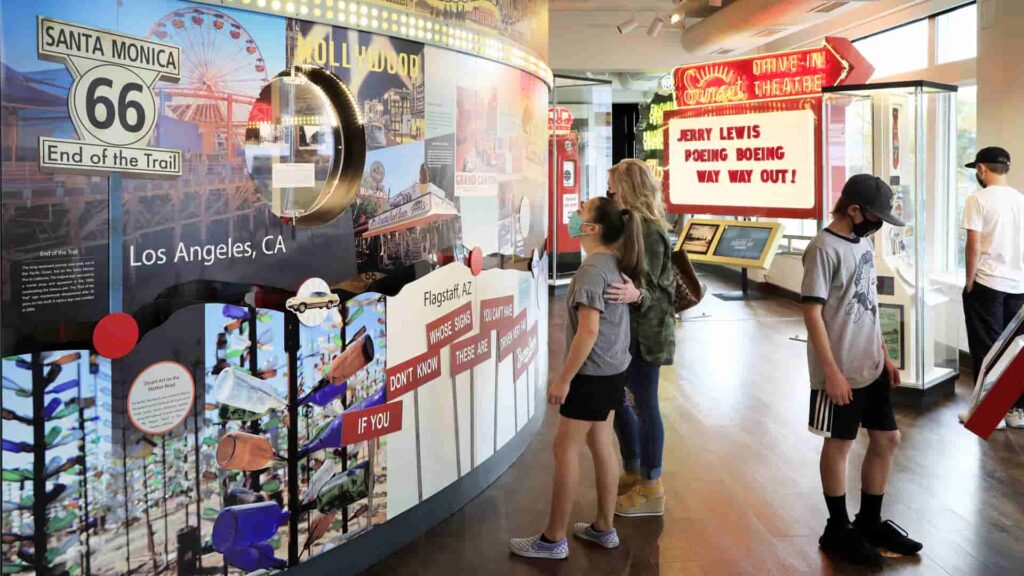At the History Museum on the Square, one of the best things to hear from young visitors are sentences beginning with I. Sentences, declared with confidence and enthusiasm, like: “I go to Phelps Grove Park with my family all the time.” “I rode a train just like this.” “I live next to that field where my dad says there was a big fight.”
These I statements are my favorite because they can lead to conversations that connect children to local history and get them excited to learn more. “Phelps Grove Park was where the Springfield Zoo used to be. Do you know where the zoo is now?” “This train is powered by steam and used to be the main way to travel from city to city before highways and cars.” “That is Wilson’s Creek Battlefield. An important battle of the Civil War was fought there over 150 years ago.”
For children, learning about local history has the greatest impact when they can relate to it. They can see directly how the past has influenced the present, impacted their community, and shaped their own lives. There are many reasons it is important for dads to seize this opportunity to forge this connection. Here are my top 5:
.jpg)
Local history promotes curiosity and meaningful learning.
Names, dates, facts, and figures are not enough to pique the curiosity of every child. When a child’s learning is centered in the place they live, they can make more meaningful connections to the past. Local history allows students to grow curious about their surroundings, to want to know more about the history that was made around them. A 2014 study from UC Davis confirmed that curiosity both prepares the brain for learning and makes the process of learning more enjoyable (Gruber, Gelman, and Ranganath, 2014), meaning that fostering your child’s curiosity about local history helps them develop an inquisitive mind and makes learning more rewarding.
.jpg)
Local history develops empathy and understanding for others.
When children seek to understand more about the past, they seek to understand more about the different people who lived it. Learning about local history helps children imagine what life was and is like in someone else’s shoes, fostering empathy for people of the past and present. Additionally, when parents engage in empathetic conversations about history with their children, it allows them to be an important part of guiding moral growth.
.jpg)
Local history strengthens their sense of identity.
Learning about local history strengthens a child’s understanding of themselves. Children can relate to historical figures, noting the similarities and differences between themselves and the people who shaped their hometown. I’ve seen children who visit the museum, especially those who participate in our Meet Missouri program, relate to a number of different people from Springfield’s past. From Springfield pioneer or Civil War soldier to schoolhouse teacher or Route 66 business owner, children can aspire to share these individuals’ strengths and learn to be critical of their bad choices. They can grow more confident in their identity and their place in their community’s history.
.jpg)
Local history connects children to their community.
Local history tells the stories of our community. As part of our mission, the History Museum on the Square works to share the stories of our community to engage, educate, and inspire. I see children in the museum every day engaging with the stories of our collective past, coming to know more about their cultural heritage, and identifying their place in our community today. At the museum, children come to view our community as an important part of American history. They see the impact local individuals made on our community and the impact our community has made on the nation. Learning about local history helps connect children to our community’s past and motivates them to become active participants in its future.
.jpg)
Local history brings families together.
The best way to connect your child to local history is to explore the past together. Bring your child to your local history museum. Take them to visit local landmarks and historic sites. Walk a heritage trail and look for historic markers together. Use these activities to experience history where it happened and learn about the past through play and conversations together. Teaching your child about local history allows you to share stories of your family’s past and talk about your own personal connections to history. You will simultaneously strengthen you and your child’s connection to your community’s past, to your family’s history, and to each other.
Gruber, M. J., Gelman, B. D., & Ranganath, C. (2014). States of curiosity modulate hippocampus-dependent learning via the dopaminergic circuit. Neuron,Vol. 84 (No. 2), 486–496. https://doi.org/10.1016/j.neuron.2014.08.060
Photos by Jeffrey Sweet of Jeffrey Sweet Photography, Springfield, MO.




